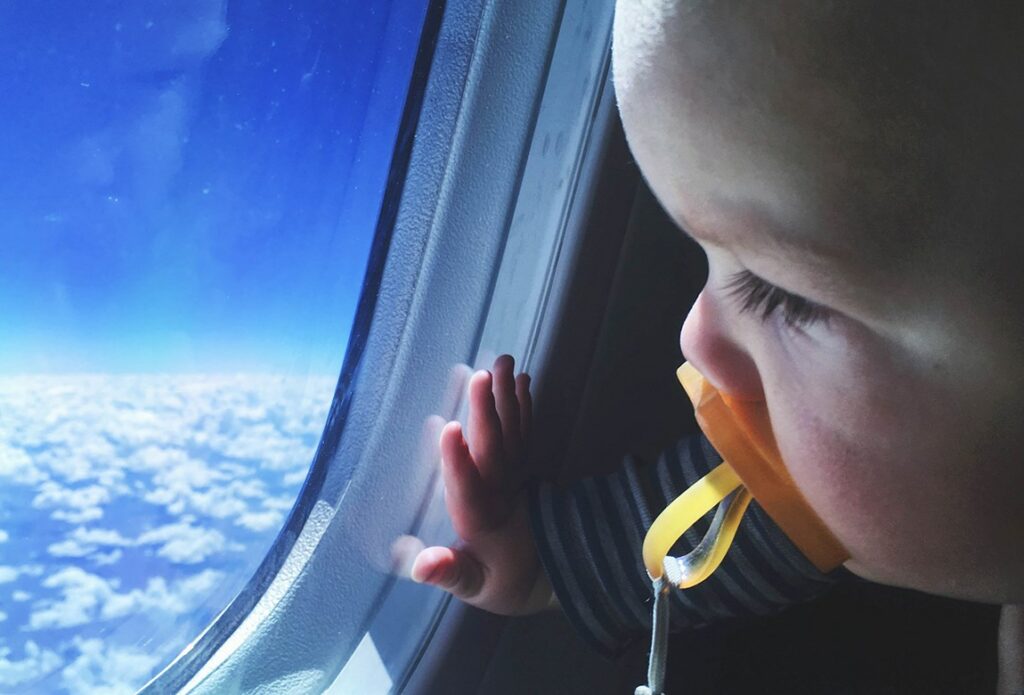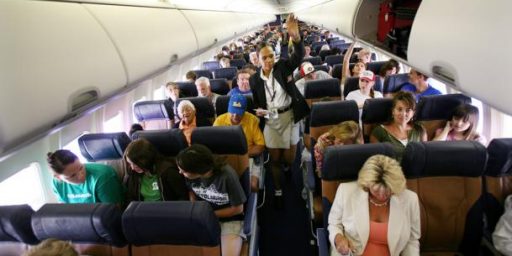Babies on a Plane
Safety, trade-offs, and risk assessment.

WaPo (“Flight attendants want to ban lap-babies on planes“):
When the seat belt light blinks on, every passenger buckles up except for one group of fliers: lap-babies. Unrestrained children sharing a seat with their parents are exempt from the safety mandate
For those who’ve never flown with small children, US carriers allow those under 2 to fly without a seat. Indeed, because my oldest was born on New Year’s Eve, we took a holiday trip wherein we had to buy an extra seat on the return flight.
presenting a growing concern amid recent incidents of severe turbulence.
“We’ve seen airplanes go through turbulence recently and drop 4,000 feet in a split second,” said Sara Nelson, the international president of the Association of Flight Attendants-CWA. “The G-forces are not something even the most loving mother or father can guard against and hold their child. It’s just physically impossible.”
The union is pressing for a rule change that would require all passengers, regardless of age, to occupy an airplane seat with a restraint.
Put that way, it seems quite reasonable. And yet: Why is it that we never hear of the tens of thousands of babies dying needlessly each year from turbulence-related issues?
The AFA-CWA raised the issue Wednesday at the Federal Aviation Administration safety summit in Northern Virginia and has submitted its list of priorities, including “a seat for every soul,” to Congress. Legislators are in the process of crafting an FAA reauthorization bill, which expires in September. The union submitted the same recommendation during the last round of reauthorization in 2018.
The tragedy that haunts Nelson occurred in 1989, when United Flight 232 crash-landed in Sioux City, Iowa. Following protocol, the flight attendants instructed the parents to wrap their unbuckled babies in blankets and place them on the floor. Three of the infants suffered injuries, and one died.
“Sadly this has been more than a 30-year priority for our union,” Nelson said. “We must have children safe on the plane and in their own seats with a proper restraint device to make sure it never happens again.”
In 1994, the debate reemerged when a little girl sitting on her mother’s lap died in a USAir crash in Charlotte.
“The safest possible thing is for everybody to be restrained,” said Ben Hoffman, president-elect of the American Academy of Pediatrics.
So, let’s stipulate that even one dead baby is a tragedy we should strive to prevent. But we’re talking two incidents in the last quarter-century? Both of which involved actual airplane crashes, not mere turbulence? And, at the risk of being insensitive, we don’t know that these two babies would have survived the crash had they been in a seat.
According to the FAA’s Civil Air Regulation Section 40.174, “A seat and an individual safety belt are required for each passenger and crew member excluding infants, who are in other than a recumbent position.”
Over the years, a variety of organizations and experts have contested the wisdom of this regulation, including the National Transportation Safety Board and the White House Commission on Aviation Safety and Security.
On many foreign carriers, parents can (loosely) secure their child with a belly loop belt that wraps around the baby’s torso and attaches to the adult’s seat belt. However, the FAA prohibits this accessory on U.S. carriers because of its potential dangers.
“During dynamic testing, the forward flailing of the adult and the child resulted in severe body impacts against the forward seat,” the agency stated in an advisory circular that addresses the supplemental belt.
Hoffman said the safest option is for parents to purchase a seat for their infant or toddler and secure them in an FAA-approved child restraint system (or car seat, in parenting vernacular). The agency has also certified a harness-like contraption called the Child Aviation Restraint System, or CARES, which the company AmSafe recommends for children weighing 20 to 40 pounds.
Interestingly, the FAA echoes this position. In its “Flying with Children” overview, the agency states: “The safest place for your child under the age of two on a U.S. airplane is in approved child restraint system (CRS) or device, not in your lap. Your arms aren’t capable of holding your in-lap child securely, especially during unexpected turbulence, which is the number one cause of pediatric injuries on an airplane.”
The International Air Transport Association’s Best Practices Guide also recommends that parents tuck their children into a restraining device approved by the country’s safety regulator and the airline. But the association concedes: “If the responsible person does not provide an approved infant restraint system, or if the CRS is not accepted in accordance with the airline’s policy or State regulations, the infant should be held by a responsible person.”
I’ve also flown on international flights where basinet-like devices were provided for babies, thus making them completely untethered. This would be dangerous in the event of a crash! But, since crashes are mind-bogglingly rare events, one presumes the tradeoff has been made to make babies and other passengers more comfortable on the flight.
The obvious argument against requiring parents to purchase a seat for infants, at a cost of hundreds of dollars, is that it would discourage them from flying altogether. The less obvious point is that the alternatives are way worse:
Hoffman recognizes the drawbacks of requiring parents to purchase airplane tickets for their youngsters. The main concern is that families will not be able to afford the airfare and will resort to driving, a more perilous mode of transportation.
“If they travel by car instead, they will actually be putting themselves at a significantly greater risk, because car crashes are so much more common than airplane incidents, whether it’s a crash or turbulence,” Hoffman said.
To emphasize his point, he cited a 2003 study published in the Journal of the American Medical Association Pediatrics that assessed the risks to children if families switched from air to car travel. The researchers determined that if as few as 5 to 10 percent of travelers hit the road instead of flying, the number of infant deaths caused by car accidents would likely exceed the number of fatalities averted by requiring child restraints on planes.
“Unless space for young children in restraint seats can be provided at low cost to families, with little or no diversion to automobile travel, a policy requiring restraint seat use could cause a net increase in deaths,” the researchers concluded.
Hoffman said the best solution is for airlines to discount tickets for young travelers. “That would be great if the airline provided some mechanism to support the parents and not charge a full fare,” he said. “But the current system is cost prohibitive for many families.”
But, of course, airlines are already squeezed on a pricing basis. Making seats (presumably, middle seats, which are the least desired by adult passengers) for babies cheaper cuts into that and would presumably make airlines, who already prefer business passengers, even more unfriendly to families.





As I’ve mentioned here before, I was born overseas and lived abroad as a child/into my teens. One of my father’s more interesting stories was about how they flew with me when I was 8 months old. He says that back then, some of the international flights–he thinks this might have been specific to Pan-Am–had special seats for parents with infants, which were essentially bulkhead-type seats and there were padded drawers where they buckled me in, directly in front of where they were sitting.
Turbulence is definitely a concern, but realistically, an infant probably is going to be held for most of a flight regardless. It’s a strange, loud environment.
Do they want all the babies to cry throughout the flight, because this is how you get crying babies throughout the flight.
We’re talking two deaths of infants, but the WAPO quote speaks of “pediatric injuries” in turbulence, so we seem to be talking some unknown number of fatal injuries.
Long ago Audi kind of got screwed on “sudden acceleration”. Part of the problem was that no one wanted to be the person to tell the young mother she’d stepped on the throttle, not the brake, and was responsible for crushing her kid against the wall. This situation may turn on no one wanting to not appear 100% committed to child safety.
I’m a bit surprised this is coming from the FA unions and not the airlines’ front offices.
After all, what’s the liability for, say, Delta if an infant dies or is severely injured due to turbulence?
BTW, you can at any time buy a ticket and seat for a lap infant. You just aren’t required to do so.
*Better one infant should die than thousands of parents be subjected to a ticket charge* is not as good a look as people imagine it to be. Still in all, not my kids so I don’t care about their safety. As long as the parents are aware of their assumed risk and have acknowledged it, whatever all y’all want is fine.
@Just nutha ignint cracker: The “ticket charge,” while not insubstantial compared to what seems to be two deaths out of who knows how many millions of baby flights, isn’t the only issue. If they opt to drive instead of fly, they’re drastically upping the risk.
While I wish people would just stop having infants, …
Actually, that pretty much summarizes my entire stance. I’m not so big on the whole continuation of the species thing. Sure, Gen Z looks better than the Boomers right now, but that will probably change. Gen X votes for a lot of Republicans, and they used to be cool too.
The cephalopods and the corvids would prefer we just get out of the way.
@James Joyner: if actually having to go to an airport is not enough of an encouragement to drive if possible, I don’t think an extra ticket is going to sway things, especially if they need/want a car at the other end.
I suspect more people will just stay where they are and not travel if the cost is too high.
Babies should be stored under the seat in front of you.
No one wants to address the fact that a baby will not do well in an air accident.
Almost no one, that is.
In the 1993 film “Fearless”, Jeff Daniels made it very clear to a tortured mother (played by Rosie Perez) that her child, which had died in a plane crash, was not her fault. In fact, there is no way that a mother could have held onto a child in an air accident.
While not his best film (as his filmography is lengthy), it makes it painfully evident that anyone with a lap infant on a plane is just fooling themselves.
@Kathy: “After all, what’s the liability for, say, Delta if an infant dies or is severely injured due to turbulence?”
My guess is none. It would be an insurance matter.
@Michael Reynolds: I dunno, have you seen his much space is in those redesigned overhead bins?
Just for the US: I do not know of a parent of an infant who does not already have a child seat for their cars which could be buckled into a passenger seat just like a car seat. Seems the way to go, and for the few that don’t have one, no need to purchase. The airlines could keep a few around, available for (yet another) small fee.
Babies vs snakes?
🙂
(OK, bad John, I know)
@JohnSF:
Dammit, John, shhhhhh… I’m doing final polish on the screenplay…